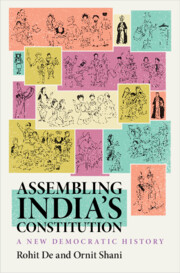Refine search
Actions for selected content:
615749 results in History
4 - Soldiers at War and Peace
-
- Book:
- Armed Citizens and Citizens in Arms
- Published online:
- 12 September 2025
- Print publication:
- 25 September 2025, pp 134-185
-
- Chapter
- Export citation
Part III - Unsettling Environments: Threat, Loss, and Precarity in Russia’s Peatlands
-
- Book:
- Burning Swamps
- Published online:
- 06 September 2025
- Print publication:
- 25 September 2025, pp 169-230
-
- Chapter
- Export citation
A Note on Usage
-
- Book:
- Burning Swamps
- Published online:
- 06 September 2025
- Print publication:
- 25 September 2025, pp xiv-xv
-
- Chapter
- Export citation
Index
-
- Book:
- Burning Swamps
- Published online:
- 06 September 2025
- Print publication:
- 25 September 2025, pp 263-272
-
- Chapter
- Export citation
Introduction
-
- Book:
- Armed Citizens and Citizens in Arms
- Published online:
- 12 September 2025
- Print publication:
- 25 September 2025, pp 1-28
-
- Chapter
- Export citation
What’s Sex Got to Do with It? Traffic and Protection in Lebanon’s Civil War
-
- Journal:
- International Journal of Middle East Studies , First View
- Published online by Cambridge University Press:
- 25 September 2025, pp. 1-21
-
- Article
-
- You have access
- Open access
- HTML
- Export citation

Assembling India’s Constitution
- A New Democratic History
-
- Published online:
- 24 September 2025
- Print publication:
- 09 October 2025
Informal Metropolis: Life on the Edge of Mexico City, 1940–1976. By David Yee . Lincoln: University of Nebraska Press, 2024. Pp. 306. $99.00 cloth; $30.00 paper; $30.00 eBook.
-
- Journal:
- The Americas , First View
- Published online by Cambridge University Press:
- 24 September 2025, pp. 1-2
-
- Article
- Export citation
“Slavery-Free”: Labour at the Todos os Santos Factory (Bahia, ca. 1840–1870)
-
- Journal:
- Itinerario , First View
- Published online by Cambridge University Press:
- 24 September 2025, pp. 1-21
-
- Article
-
- You have access
- Open access
- HTML
- Export citation
Taken Not Given: The End of Slavery in Britain
-
- Journal:
- Law and History Review , First View
- Published online by Cambridge University Press:
- 24 September 2025, pp. 1-32
-
- Article
-
- You have access
- Open access
- HTML
- Export citation
How the Spanish Empire Was Built: A 400 Year History. By Felipe Fernánez-Armestoand Manuel Lucena Giraldo . London: Reaktion Books, 2024. Pp. 352. $40.00 cloth.
-
- Journal:
- The Americas , First View
- Published online by Cambridge University Press:
- 24 September 2025, pp. 1-2
-
- Article
- Export citation
Introduction: Hidden economies of slavery
-
- Journal:
- Itinerario , First View
- Published online by Cambridge University Press:
- 24 September 2025, pp. 1-10
-
- Article
-
- You have access
- Open access
- HTML
- Export citation
Escritura entre restos: Carne, archivo y montaje en Cadáver exquisito (2017), de Agustina Bazterrica
-
- Journal:
- Latin American Research Review ,
- Published online by Cambridge University Press:
- 24 September 2025, pp. 1-18
-
- Article
-
- You have access
- Open access
- HTML
- Export citation
Daniel Aschheim. Kreisky, Israel, and Jewish Identity. New Orleans: University of New Orleans Press, 2022. Pp. 235.
-
- Journal:
- Austrian History Yearbook , First View
- Published online by Cambridge University Press:
- 24 September 2025, pp. 1-3
-
- Article
- Export citation
Counting the Stakes: A Reassessment of Vlad III Dracula’s Practice of Collective Impalements in Fifteenth-Century South-eastern Europe
-
- Journal:
- Transactions of the Royal Historical Society , First View
- Published online by Cambridge University Press:
- 23 September 2025, pp. 1-16
-
- Article
-
- You have access
- Open access
- HTML
- Export citation
International Symposium Academic Freedom in the Twenty-First Century
-
- Journal:
- European Review / Volume 33 / Issue S1 / March 2025
- Published online by Cambridge University Press:
- 23 September 2025, p. Siii
-
- Article
-
- You have access
- Open access
- HTML
- Export citation
Academic Freedom in the Twenty-First Century – ADDENDUM
-
- Journal:
- European Review / Volume 33 / Issue S1 / March 2025
- Published online by Cambridge University Press:
- 23 September 2025, pp. S176-S177
-
- Article
-
- You have access
- Open access
- HTML
- Export citation
Edward B. Davis, Protestant Modernist Pamphlets: Science and Religion in the Scopes Era Baltimore: Johns Hopkins University Press, 2024. Pp. 336. ISBN 978-1-4214-4982-1. $64.95 (hardcover).
-
- Journal:
- The British Journal for the History of Science , First View
- Published online by Cambridge University Press:
- 23 September 2025, pp. 1-2
-
- Article
-
- You have access
- HTML
- Export citation
Simon Webb, Exploring Roman London. Barnsley: Pen & Sword History, 2023. Pp. 224, illus. isbn 9781399058490 (pbk). £16.99. - Andrew Tibbs, A Short Guide to Roman London. Stroud: Amberley Publishing, 2024. Pp. 126, illus. isbn 9781398117952 (pbk). £16.99.
-
- Journal:
- Britannia , First View
- Published online by Cambridge University Press:
- 23 September 2025, pp. 1-2
-
- Article
- Export citation
Introduction to Academic Freedom in the Twenty-first Century
-
- Journal:
- European Review / Volume 33 / Issue S1 / March 2025
- Published online by Cambridge University Press:
- 23 September 2025, pp. S1-S13
-
- Article
-
- You have access
- Open access
- HTML
- Export citation
